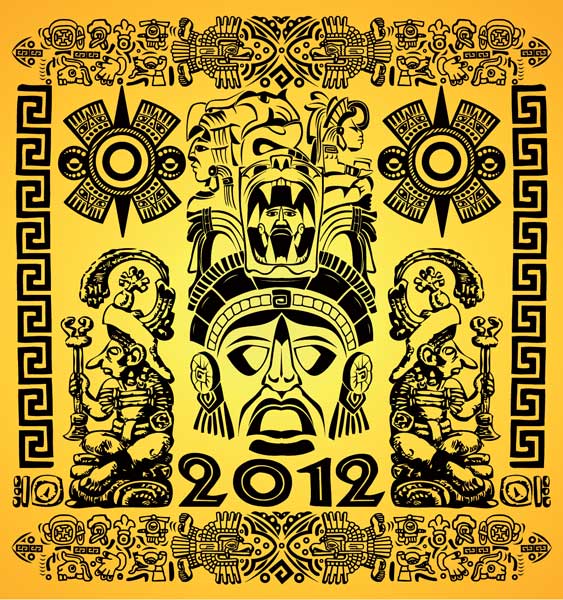FELIPE CARRILLO PUERTO, Mexico (RNS) Mayan pilgrims often come here to a simple church with a thatched roof to venerate the Cruz Parlante, or Speaking Cross, which gave their forefathers guidance during a 19th-century rebellion.

(RNS1-dec20) Thrill seekers, partyers and folks seeking spiritual experiences are pouring into the Yucatan Peninsula for the end of the centuries-long Mayan calendar that some believe predicted the end of the world Friday. *Note: This image is not available to download. RNS photo courtesy Shutterstock.
But priest Alfonso Ek says lately he’s being asked by curious non-Mayans about something he says has nothing to do with his people or their beliefs: the end of the world.
His response: “The world will not end.”
Thrill seekers, partyers and folks seeking spiritual experiences are pouring into the Yucatan Peninsula for the end of the centuries-long Mayan calendar that some believe predicted the end of the world Friday. The Mayan people here appear to be greeting the event serenely, with a sense of humor and bemusement.
The ancient Mayans, who ruled throughout southern Mexico and Central America until about 900 A.D., used three calendars, one of which was the Long Count Calendar that completes a major cycle on Dec. 21, 2012. Some today have claimed that the date signifies the end of the world, while scholars say it is merely the beginning of another cycle.
The Maya still exist today as a diverse number of indigenous peoples, some of whom still speak the Maya language.
The end of the Mayan calendar put the spotlight on a people known for human sacrifices and celebrated for their past prowess in subjects such as math and astronomy. Today they live largely on the margins of the lands conquered by the Spaniards beginning in the 16th century.
The Mayans across the Yucatan Peninsula were in rebellion throughout the later half of the 1800s, angered at discrimination and being treated as slaves by those of European descent. At the church here, they looked upon the “Speaking Cross” as an oracle in what is known as the War of the Castes. The Mexican army ended the uprising in 1901.
Ek, who conducts a Mayan form of Mass at his church, plans to mark the new calendar with prayer and traditional ceremonies, which he says many Maya have abandoned for other faiths, along with their language. He says this rejection of their culture might bring plagues, disease and drought.
Yet most people, says local museum guide Karla Chan Poot, “are receiving Dec. 21 with calm.”
“People believe that they’re going to see a change, in humanity, in our thinking, that there should be a return to nature,” Chan says. “This won’t be anything like the world ending, or a meteor crashing, or extraterrestrials arriving,” or anything depicted in popular culture or movies.
News of the pending end has reached people here, like aspiring Mayan artist Marco Poot Cahun, who incorporates doomsday talk into his monologues – which he delivers in Maya.
“If I ask (an audience) if they believe the world will end, no one will raise their hand,” he says.
How the idea sprouted that the Mayans predicted the end of the world remains a mystery to many. Jose Manuel Ochoa, archaeologist and director of the Mayan Ruins at Coba, says the Mayans were known for their ability to measure time, and the Mayan calendar has been interpreted many different ways.
He says the Long Count Calendar lasts 5,125 years, and that it began sometime in mid-August, 3714 B.C. On Friday, it concludes the third cycle, each one marked by men created by Mayan gods from various materials: mud, wood and, most recently, corn. What comes next is unknown, he says – “maybe men of plastic,” he jokes.
The Maya built impressive monuments, temples and cities and a system of pre-Hispanic stone paths known as “sacbes.”
The Maya suffered under Spanish rule and were treated “almost like slaves,” harvesting henequin, a plant with sword-shaped leaves, for making rope, Ochoa says.
Many modern-day Maya in the Yucatan live better, although poverty persists. Some still reside in villages where only Maya is spoken and live in traditional houses with thatched roofs. Traditions such as white clothing and tricycle taxi service are common.
In the traditional settlements, “the grandmas there won’t drink Coca-Cola. They prefer their atole,” a corn gruel beverage, Poot Cahun says.
Others earn livings in tourism, which began in Cancun only in the late 1970s. Ochoa says each of the 150 Mayans living on a collective property near Coba earn $1,200 every two months by offering tricycle taxi service at the ruins.
Chan says tourism draws many, although wages are often low.
“People in the north (of Mexico) have the American dream,” she says. In the Yucatan Peninsula, many Mayans dream of tourism jobs, Chan says – even though their language, which is widely spoken in smaller settlements, is unwelcome and can lead to discrimination.
Some professionals have changed names, she says – Ek, for example, was once “Estrella” (star) in Spanish. Despite ignorance of their culture, many Mayans see an upside to the erroneous interpretation of their calendar.
“People in faraway places didn’t know we existed,” Ek says. “Now they’re coming here.”
LEM/AMB END AGREN




